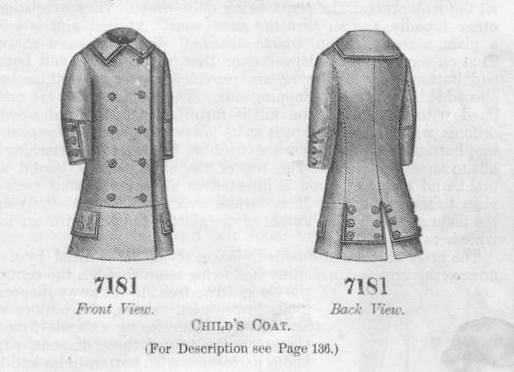
The Delineator Chronology: Child's Coat (September 1880)

Figure 1.-- Garment No. 7181 is a child's coat, meaning it could be worn by a boy or girl, 1-6 years of age. It is an outer garment made in the style of a ladies' coat. Note the skirted look of the lower portion of the coats. It blouses out to accomodate a fress or other skirted garment. Boys of this age commonly wore skirted garments at the time.
|
|
Garment No. 7181 is a child's coat, meaning it could be worn by a boy or girl, 1-6 years of age. It is an outer garment made in the style of a ladies' coat. Note the skirted look of the lower portion of the coats. It blouses out to accomodate a fress or other skirted garment. Boys of this age commonly wore skirted garments at the time. This article appeared on page 136 of the Delineator September 1880 issue. The illustration was on page 137.
The Delineator
The Delinleator was an especially important publication for fashion history. Along with the illustrations were very detailed discussions of the contruction, ornamentation, and fabrics. This article appeared on page 136 of the Delineator September 1880 issue. The illustration was on the page 137.
Garment Type
Garment No. 7181 is a child's coat, meaning it could be worn by a boy or girl, 1-6 years of age. It is an outer garment made in the style of a ladies' coat. Note the skirted look of the lower portion of the coats. It blouses out to accomodate a fress or other skirted garment. Boys of this age commonly wore skirted garments at the time.
Gender
The Dileneator suggests this garment for both boys and girls of 1-6 years of age. This is inteesting because kilt suits themselves were a boys' garment.
Ad Copy
No. 7181.--The chief characteristics of this coat are in graceful adjustment and the arrangement of its lower portion, which, though not at all elaborate, is very attractive, following quite closely the mode in ladies' coats. The fronts, which are double-breasted, are fitted entirely by seams upon the shoulders and under the arms, and have their front edges folded under its wide, broad hems. The back is a little deeper than the front, and is adjusted by a center seam, which terminates just the distance of the extra length from the bottom. A skirt-portion, which is straight at its front edge and turned under in a hem, is then joined to each side, a tiny, forward-turning plait being folded in it at the under-arm seam. The back of this skirt-section passes under the extra length of the body, and is turned under in a narrow hem. The skirt is quite narrow, and its addition imparts a very jaunty air to the coat. Upon each side is a long narrow pocket-lap, and about the neck is ac charming collar, which curves over the sholders and is nearly straight across the back. The material selected for the model is camel's-hair of a chocolate-brown shade, and brown satin pipings finish the collar and pocket-laps. each of the latter is further ornamented with three vegetable-ivory buttons and simulated button-holes. The sleeve is trimmed with pipings and buttons to simulate a cuff, and the same embelishments are added upon the extra length of the back. Button-holes and buttons close the front from the throat to the skirt, and a row of buttons is placed on the overlapping side parallel with those used in clothing.
Coatings or suitings of any kind adapted to the season make up satisfactorily in this way, and may be trimmed with braid, stiyching, fur, cordings, ect. A very pretty coat of the kind is made up of prune-colored corduroy and finished with stitching. Another is of plain cloth, with velvet pipings. A reference to Child figure No. 3 on this page will also disclose another method of finishing such a garment. This model will be frequently selected for the first coat worn by little toddlersafter they have taken off their baby wrappings. Écry, bright, dark and navy blue, seal brown, chocolate-brown, gray, olive, the various wool tints, drab, pearl and peacock-blue are the most fashionable colors for children's coats, and their finish may be elaborate or simple as preferred, lace providing a daintyb ornament for them.
We have pattern No. 7181 is in six sizes for children from one to six years of age. If material twenty-two inches wide be selected for the garment, three yards and three-eights will be required in its construction for a child of four years. If goods forty-eight inches will be chosen, one yard and a-half will suffice for the purpose. Price of patter, 7d. or 15 cents.
Material
The Delineator did not suggest a specific material for this coat. It could be made in different weights. The magazine uses the term "coatings" or "suitings", meaning material used to make suits and coats. These were commonly used termns--especizlly "suitings".
Colors
There is considerable suggestions as to the appropriate colors for these coats, mostly shades of blue, brown, gray, olive off white. These would seem to be shades commonly used for boys' clothes, except perhaps the off white. We are not sure if coats specifically for girls would have been made in brighter colors.
HBC

Navigate the Boys' Historical Clothing Web Site:
[Return to the Main "Delineator" chronology page]
[Return to the Main "Delineator" page]
[Return to the Main U.S. fashion magazine country page]
[Return tp the Main fashion publishing page]
[Return tp the Main U.S. catalog page]
[Introduction]
[Activities]
[Biographies]
[Chronology]
[Clothing styles]
[Countries]
[Topics]
[Bibliographies]
[Contributions]
[FAQs]
[Glossaries]
[Images]
[Links]
[Registration]
[Tools]
[Boys' Clothing Home]
Navigate the Boys' Historical Clothing Web Site:
[Sailor suits]
[Sailor hats]
[Buster Brown suits]
[Eton suits]
[Rompers]
[Tunics]
[Smocks]
[Pinafores]
Created: 6:42 PM 1/14/2008
Last updated: 6:42 PM 1/14/2008



